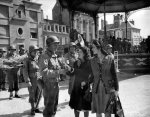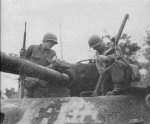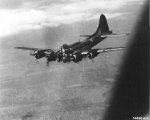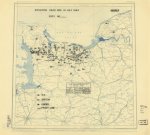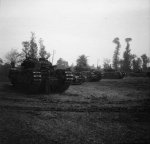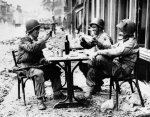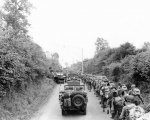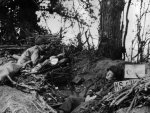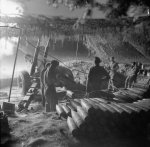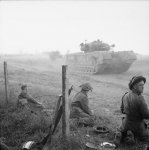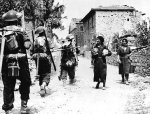July 13, 1944: The Americans continue to push forward in the south of Cotentin, despite slow advances in the area of Martinville. They are stuck in the Normand bocage by Germans who have built up defensive positions. The American Sherman tanks are vulnerable as they climb the hedgerows and lose many tanks to the Germans, camouflaged in the fortress-like hedges. The American engineers equip the Sherman tanks with huge iron teeth salvaged from German beach obstacles, welded to the front, which cut the vegetation in front of the vehicle, allowing faster progress as well as a new camouflage thanks to the branches which remain hung between the blades. They nick-name the Culin hedgerow cutter the Rhinoceros. Tank and infantry units began to support each other - the tanks supplying the heavy firepower needed to eliminate the enemy's well-sited firing positions while the infantry keeps enemy soldiers with antitank weapons at bay. The Rhinos are an ingenious creation, allowing American armor to move across the country at will while the German tanks continue to make do primarily with the roads. In spite of violent engagements which weaken the German troops, the American progress is still slow - a situation which worries General Bradley, who begins working on a possible great scale offensive allowing the opening of the front.
The British and Canadian forces continue to battle in the southwest and east of Caen for total control of the city, the liberation of the villages over the Odon River and Hill 112. The fights, often including hand-to-hand combat, are extremely violent in these areas meaning human and material losses are very high for both sides.
Above France, RAF Bomber Command sends 13 aircraft to attack V-weapons site during the day. RAF 2nd Tactical Air Force conducting ground support. US 9th Air Force fighters attack ground targets in poor weather conditions.
On the eastern front, Soviet 1st Ukrainian Front launches major offensive against German Army Group North Ukraine around Brody, Radekhov, and Zolochev.
In Italy, 2nd New Zealand Division of British 8th Army captures Monte Castiglione Maggiore. French units of US 5th Army attack around Gimignano, Poggibonsi, and Castellina. US 12th Air Force bombers continue Operation Mallory Major to interdict road and rail bridges over Po River. US 15th Air Force attacks Verona, Mestre, Brescia, Mantua and other targets with 581 bombers.
The secret of the German FuG 227 Flensburg equipment, which can home-in on RAF Monica radars, is revealed when a Luftwaffe pilot lands his Junkers Ju 88G-1 night fighter by mistake at RAF Woodbridge in Suffolk, England. In addition the capture of this aircraft's FuG 220 radar will permit British scientist to find a way of jamming its signal within a matter of weeks.
Pictured: The bocage of the Cotentin peninsula; US Army soldiers being taught how to detect and disarm mines, France, July 13, 1944; Omar Bradley and Bernard Montgomery at headquarters of British 21st Army Group, Normandy, France, July 13, 1944; Churchill tank crews of 31st Tank Brigade with their extensively camouflaged vehicles, July 13, 1944
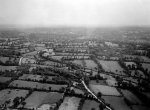
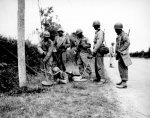
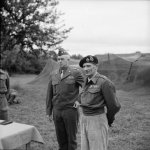
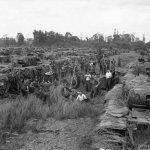
The British and Canadian forces continue to battle in the southwest and east of Caen for total control of the city, the liberation of the villages over the Odon River and Hill 112. The fights, often including hand-to-hand combat, are extremely violent in these areas meaning human and material losses are very high for both sides.
Above France, RAF Bomber Command sends 13 aircraft to attack V-weapons site during the day. RAF 2nd Tactical Air Force conducting ground support. US 9th Air Force fighters attack ground targets in poor weather conditions.
On the eastern front, Soviet 1st Ukrainian Front launches major offensive against German Army Group North Ukraine around Brody, Radekhov, and Zolochev.
In Italy, 2nd New Zealand Division of British 8th Army captures Monte Castiglione Maggiore. French units of US 5th Army attack around Gimignano, Poggibonsi, and Castellina. US 12th Air Force bombers continue Operation Mallory Major to interdict road and rail bridges over Po River. US 15th Air Force attacks Verona, Mestre, Brescia, Mantua and other targets with 581 bombers.
The secret of the German FuG 227 Flensburg equipment, which can home-in on RAF Monica radars, is revealed when a Luftwaffe pilot lands his Junkers Ju 88G-1 night fighter by mistake at RAF Woodbridge in Suffolk, England. In addition the capture of this aircraft's FuG 220 radar will permit British scientist to find a way of jamming its signal within a matter of weeks.
Pictured: The bocage of the Cotentin peninsula; US Army soldiers being taught how to detect and disarm mines, France, July 13, 1944; Omar Bradley and Bernard Montgomery at headquarters of British 21st Army Group, Normandy, France, July 13, 1944; Churchill tank crews of 31st Tank Brigade with their extensively camouflaged vehicles, July 13, 1944






